Crime in Baltimore: Analyzing Community Effects & Solutions
VerifiedAdded on 2023/04/08
|6
|1327
|315
Essay
AI Summary
This essay provides a comprehensive review of the effects of crime on communities in Baltimore. It begins by defining crime and highlighting its prevalence in urban neighborhoods, particularly in Baltimore, where high crime rates contribute to reduced employment opportunities, fewer youth activities, law enforcement issues, and mental health disorders. The essay synthesizes relevant literature to explore how communities are affected by crime, discussing the role of gun violence, illegal drug economies, and the government's inability to manage social disturbances. It examines the impact of unemployment on crime rates, the effects of exposure to violence on children, and the relationship between neighborhood conditions and obesity. Additionally, the essay explores the interconnectedness between parks, property values, and crime, and the potential for urban vegetation to both reduce and increase crime rates. The essay concludes by suggesting community-wide interventions, such as increased police presence, strict law enforcement, neighborhood watch programs, and surveillance cameras, as potential solutions to reduce crime and improve community standards in Baltimore.
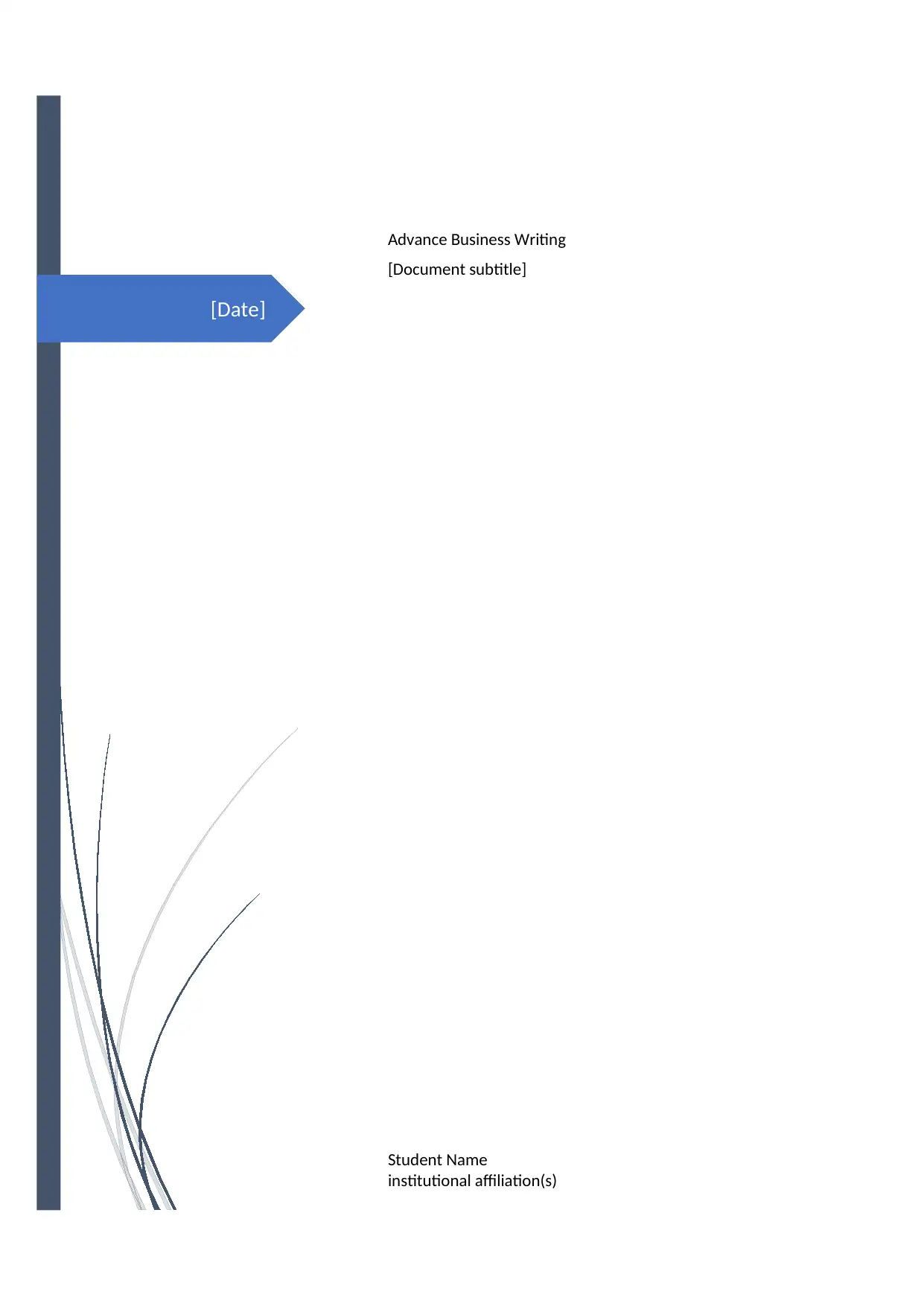
[Date]
Advance Business Writing
[Document subtitle]
Student Name
institutional affiliation(s)
Advance Business Writing
[Document subtitle]
Student Name
institutional affiliation(s)
Paraphrase This Document
Need a fresh take? Get an instant paraphrase of this document with our AI Paraphraser
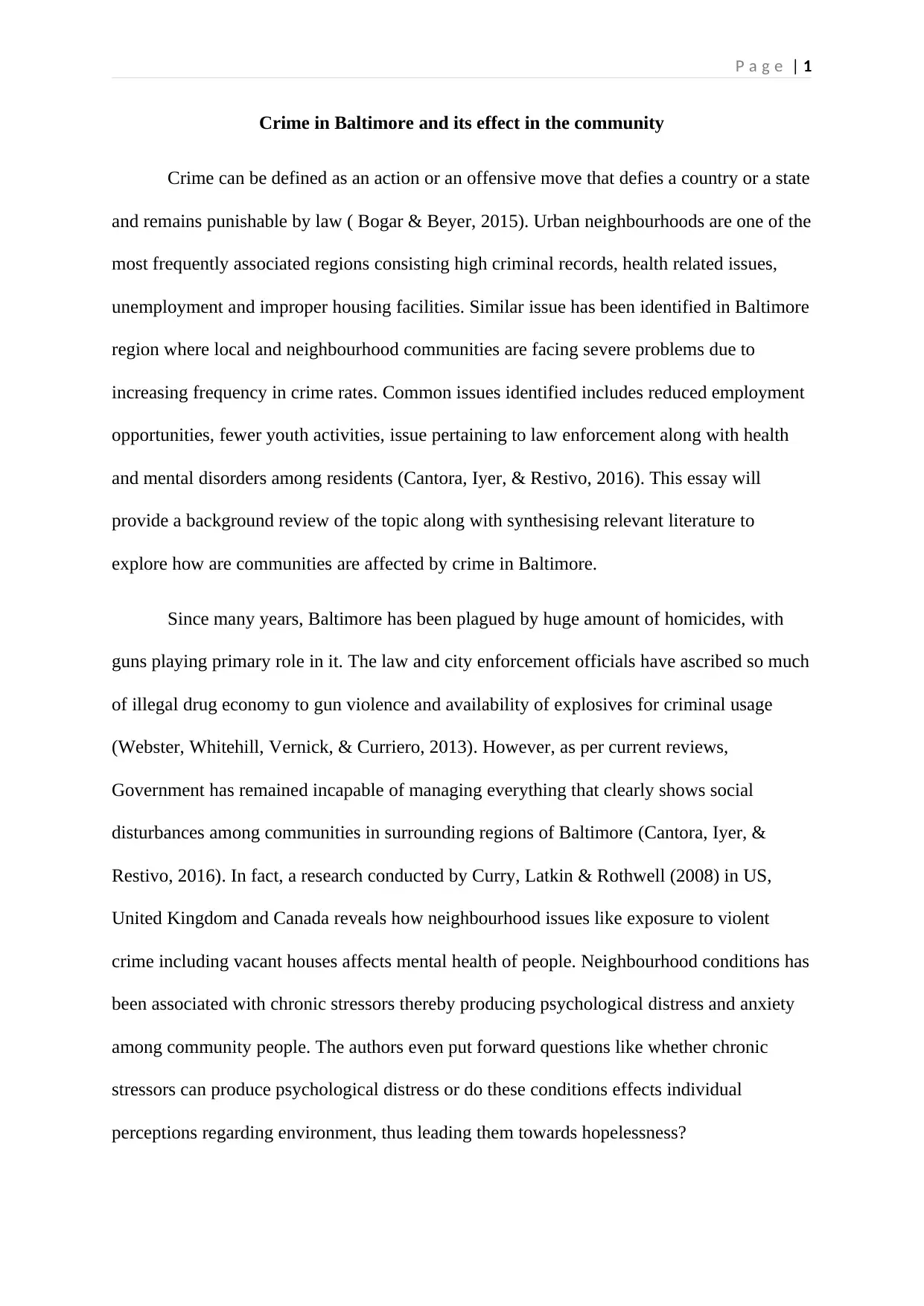
P a g e | 1
Crime in Baltimore and its effect in the community
Crime can be defined as an action or an offensive move that defies a country or a state
and remains punishable by law ( Bogar & Beyer, 2015). Urban neighbourhoods are one of the
most frequently associated regions consisting high criminal records, health related issues,
unemployment and improper housing facilities. Similar issue has been identified in Baltimore
region where local and neighbourhood communities are facing severe problems due to
increasing frequency in crime rates. Common issues identified includes reduced employment
opportunities, fewer youth activities, issue pertaining to law enforcement along with health
and mental disorders among residents (Cantora, Iyer, & Restivo, 2016). This essay will
provide a background review of the topic along with synthesising relevant literature to
explore how are communities are affected by crime in Baltimore.
Since many years, Baltimore has been plagued by huge amount of homicides, with
guns playing primary role in it. The law and city enforcement officials have ascribed so much
of illegal drug economy to gun violence and availability of explosives for criminal usage
(Webster, Whitehill, Vernick, & Curriero, 2013). However, as per current reviews,
Government has remained incapable of managing everything that clearly shows social
disturbances among communities in surrounding regions of Baltimore (Cantora, Iyer, &
Restivo, 2016). In fact, a research conducted by Curry, Latkin & Rothwell (2008) in US,
United Kingdom and Canada reveals how neighbourhood issues like exposure to violent
crime including vacant houses affects mental health of people. Neighbourhood conditions has
been associated with chronic stressors thereby producing psychological distress and anxiety
among community people. The authors even put forward questions like whether chronic
stressors can produce psychological distress or do these conditions effects individual
perceptions regarding environment, thus leading them towards hopelessness?
Crime in Baltimore and its effect in the community
Crime can be defined as an action or an offensive move that defies a country or a state
and remains punishable by law ( Bogar & Beyer, 2015). Urban neighbourhoods are one of the
most frequently associated regions consisting high criminal records, health related issues,
unemployment and improper housing facilities. Similar issue has been identified in Baltimore
region where local and neighbourhood communities are facing severe problems due to
increasing frequency in crime rates. Common issues identified includes reduced employment
opportunities, fewer youth activities, issue pertaining to law enforcement along with health
and mental disorders among residents (Cantora, Iyer, & Restivo, 2016). This essay will
provide a background review of the topic along with synthesising relevant literature to
explore how are communities are affected by crime in Baltimore.
Since many years, Baltimore has been plagued by huge amount of homicides, with
guns playing primary role in it. The law and city enforcement officials have ascribed so much
of illegal drug economy to gun violence and availability of explosives for criminal usage
(Webster, Whitehill, Vernick, & Curriero, 2013). However, as per current reviews,
Government has remained incapable of managing everything that clearly shows social
disturbances among communities in surrounding regions of Baltimore (Cantora, Iyer, &
Restivo, 2016). In fact, a research conducted by Curry, Latkin & Rothwell (2008) in US,
United Kingdom and Canada reveals how neighbourhood issues like exposure to violent
crime including vacant houses affects mental health of people. Neighbourhood conditions has
been associated with chronic stressors thereby producing psychological distress and anxiety
among community people. The authors even put forward questions like whether chronic
stressors can produce psychological distress or do these conditions effects individual
perceptions regarding environment, thus leading them towards hopelessness?
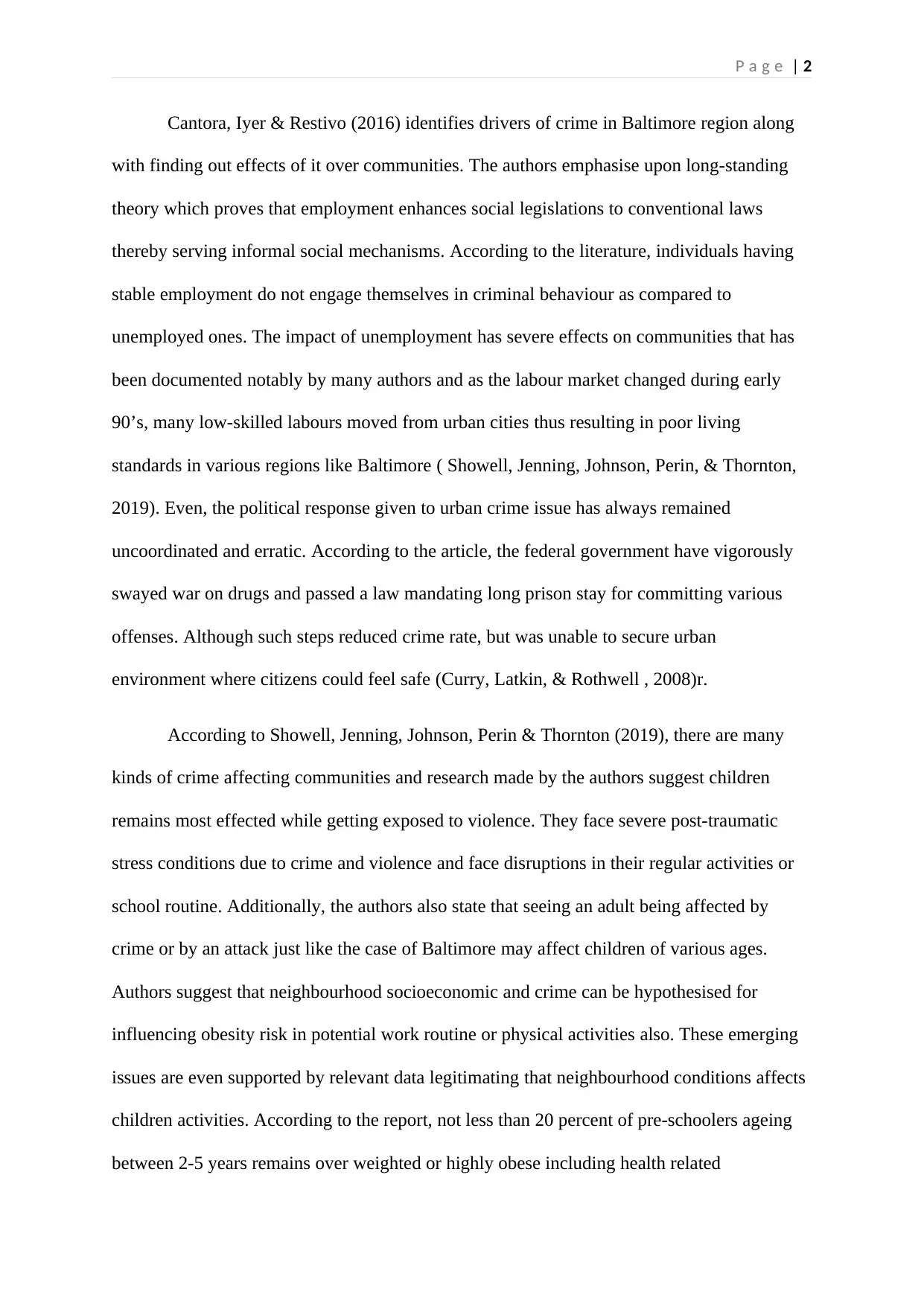
P a g e | 2
Cantora, Iyer & Restivo (2016) identifies drivers of crime in Baltimore region along
with finding out effects of it over communities. The authors emphasise upon long-standing
theory which proves that employment enhances social legislations to conventional laws
thereby serving informal social mechanisms. According to the literature, individuals having
stable employment do not engage themselves in criminal behaviour as compared to
unemployed ones. The impact of unemployment has severe effects on communities that has
been documented notably by many authors and as the labour market changed during early
90’s, many low-skilled labours moved from urban cities thus resulting in poor living
standards in various regions like Baltimore ( Showell, Jenning, Johnson, Perin, & Thornton,
2019). Even, the political response given to urban crime issue has always remained
uncoordinated and erratic. According to the article, the federal government have vigorously
swayed war on drugs and passed a law mandating long prison stay for committing various
offenses. Although such steps reduced crime rate, but was unable to secure urban
environment where citizens could feel safe (Curry, Latkin, & Rothwell , 2008)r.
According to Showell, Jenning, Johnson, Perin & Thornton (2019), there are many
kinds of crime affecting communities and research made by the authors suggest children
remains most effected while getting exposed to violence. They face severe post-traumatic
stress conditions due to crime and violence and face disruptions in their regular activities or
school routine. Additionally, the authors also state that seeing an adult being affected by
crime or by an attack just like the case of Baltimore may affect children of various ages.
Authors suggest that neighbourhood socioeconomic and crime can be hypothesised for
influencing obesity risk in potential work routine or physical activities also. These emerging
issues are even supported by relevant data legitimating that neighbourhood conditions affects
children activities. According to the report, not less than 20 percent of pre-schoolers ageing
between 2-5 years remains over weighted or highly obese including health related
Cantora, Iyer & Restivo (2016) identifies drivers of crime in Baltimore region along
with finding out effects of it over communities. The authors emphasise upon long-standing
theory which proves that employment enhances social legislations to conventional laws
thereby serving informal social mechanisms. According to the literature, individuals having
stable employment do not engage themselves in criminal behaviour as compared to
unemployed ones. The impact of unemployment has severe effects on communities that has
been documented notably by many authors and as the labour market changed during early
90’s, many low-skilled labours moved from urban cities thus resulting in poor living
standards in various regions like Baltimore ( Showell, Jenning, Johnson, Perin, & Thornton,
2019). Even, the political response given to urban crime issue has always remained
uncoordinated and erratic. According to the article, the federal government have vigorously
swayed war on drugs and passed a law mandating long prison stay for committing various
offenses. Although such steps reduced crime rate, but was unable to secure urban
environment where citizens could feel safe (Curry, Latkin, & Rothwell , 2008)r.
According to Showell, Jenning, Johnson, Perin & Thornton (2019), there are many
kinds of crime affecting communities and research made by the authors suggest children
remains most effected while getting exposed to violence. They face severe post-traumatic
stress conditions due to crime and violence and face disruptions in their regular activities or
school routine. Additionally, the authors also state that seeing an adult being affected by
crime or by an attack just like the case of Baltimore may affect children of various ages.
Authors suggest that neighbourhood socioeconomic and crime can be hypothesised for
influencing obesity risk in potential work routine or physical activities also. These emerging
issues are even supported by relevant data legitimating that neighbourhood conditions affects
children activities. According to the report, not less than 20 percent of pre-schoolers ageing
between 2-5 years remains over weighted or highly obese including health related
⊘ This is a preview!⊘
Do you want full access?
Subscribe today to unlock all pages.

Trusted by 1+ million students worldwide
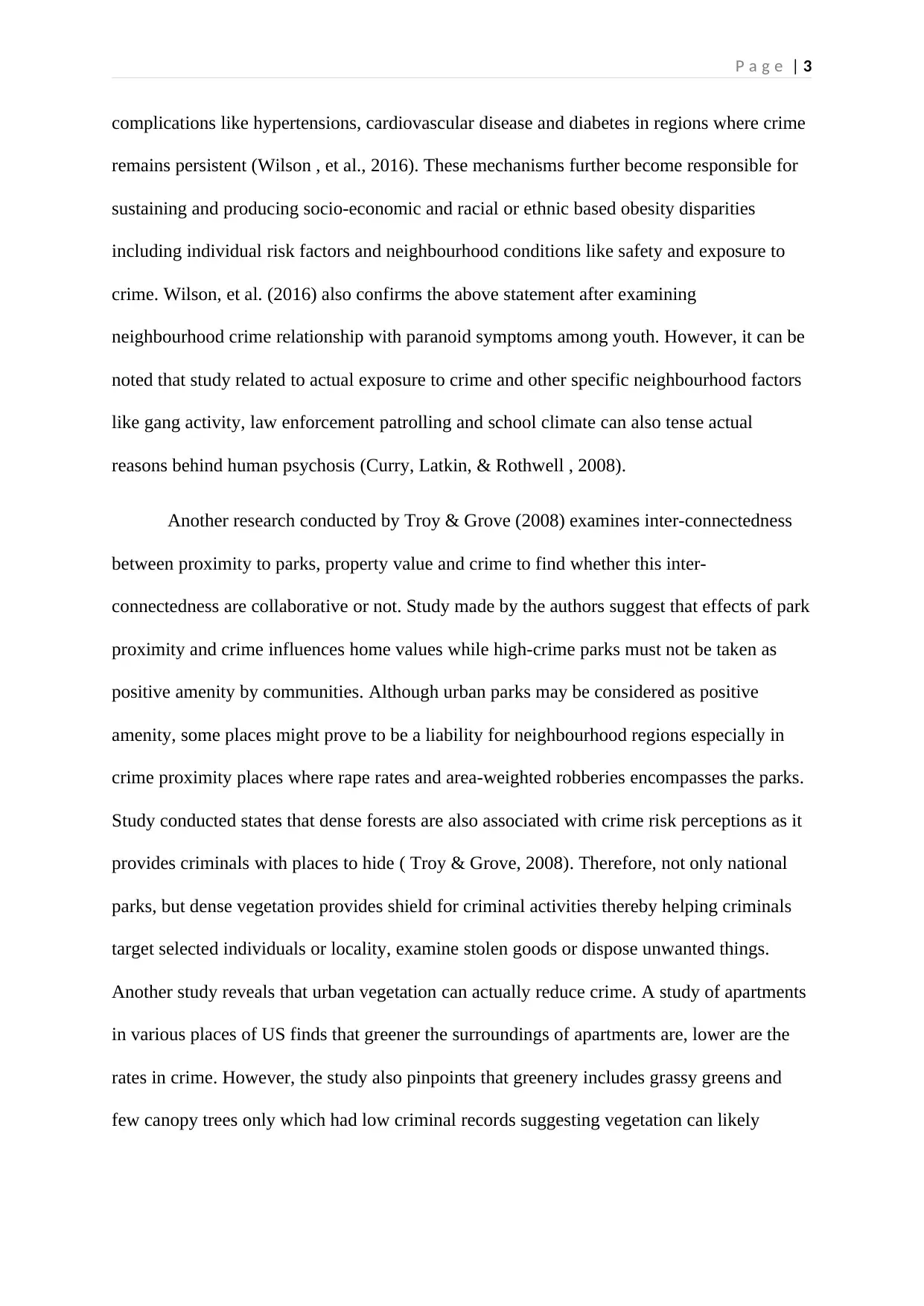
P a g e | 3
complications like hypertensions, cardiovascular disease and diabetes in regions where crime
remains persistent (Wilson , et al., 2016). These mechanisms further become responsible for
sustaining and producing socio-economic and racial or ethnic based obesity disparities
including individual risk factors and neighbourhood conditions like safety and exposure to
crime. Wilson, et al. (2016) also confirms the above statement after examining
neighbourhood crime relationship with paranoid symptoms among youth. However, it can be
noted that study related to actual exposure to crime and other specific neighbourhood factors
like gang activity, law enforcement patrolling and school climate can also tense actual
reasons behind human psychosis (Curry, Latkin, & Rothwell , 2008).
Another research conducted by Troy & Grove (2008) examines inter-connectedness
between proximity to parks, property value and crime to find whether this inter-
connectedness are collaborative or not. Study made by the authors suggest that effects of park
proximity and crime influences home values while high-crime parks must not be taken as
positive amenity by communities. Although urban parks may be considered as positive
amenity, some places might prove to be a liability for neighbourhood regions especially in
crime proximity places where rape rates and area-weighted robberies encompasses the parks.
Study conducted states that dense forests are also associated with crime risk perceptions as it
provides criminals with places to hide ( Troy & Grove, 2008). Therefore, not only national
parks, but dense vegetation provides shield for criminal activities thereby helping criminals
target selected individuals or locality, examine stolen goods or dispose unwanted things.
Another study reveals that urban vegetation can actually reduce crime. A study of apartments
in various places of US finds that greener the surroundings of apartments are, lower are the
rates in crime. However, the study also pinpoints that greenery includes grassy greens and
few canopy trees only which had low criminal records suggesting vegetation can likely
complications like hypertensions, cardiovascular disease and diabetes in regions where crime
remains persistent (Wilson , et al., 2016). These mechanisms further become responsible for
sustaining and producing socio-economic and racial or ethnic based obesity disparities
including individual risk factors and neighbourhood conditions like safety and exposure to
crime. Wilson, et al. (2016) also confirms the above statement after examining
neighbourhood crime relationship with paranoid symptoms among youth. However, it can be
noted that study related to actual exposure to crime and other specific neighbourhood factors
like gang activity, law enforcement patrolling and school climate can also tense actual
reasons behind human psychosis (Curry, Latkin, & Rothwell , 2008).
Another research conducted by Troy & Grove (2008) examines inter-connectedness
between proximity to parks, property value and crime to find whether this inter-
connectedness are collaborative or not. Study made by the authors suggest that effects of park
proximity and crime influences home values while high-crime parks must not be taken as
positive amenity by communities. Although urban parks may be considered as positive
amenity, some places might prove to be a liability for neighbourhood regions especially in
crime proximity places where rape rates and area-weighted robberies encompasses the parks.
Study conducted states that dense forests are also associated with crime risk perceptions as it
provides criminals with places to hide ( Troy & Grove, 2008). Therefore, not only national
parks, but dense vegetation provides shield for criminal activities thereby helping criminals
target selected individuals or locality, examine stolen goods or dispose unwanted things.
Another study reveals that urban vegetation can actually reduce crime. A study of apartments
in various places of US finds that greener the surroundings of apartments are, lower are the
rates in crime. However, the study also pinpoints that greenery includes grassy greens and
few canopy trees only which had low criminal records suggesting vegetation can likely
Paraphrase This Document
Need a fresh take? Get an instant paraphrase of this document with our AI Paraphraser
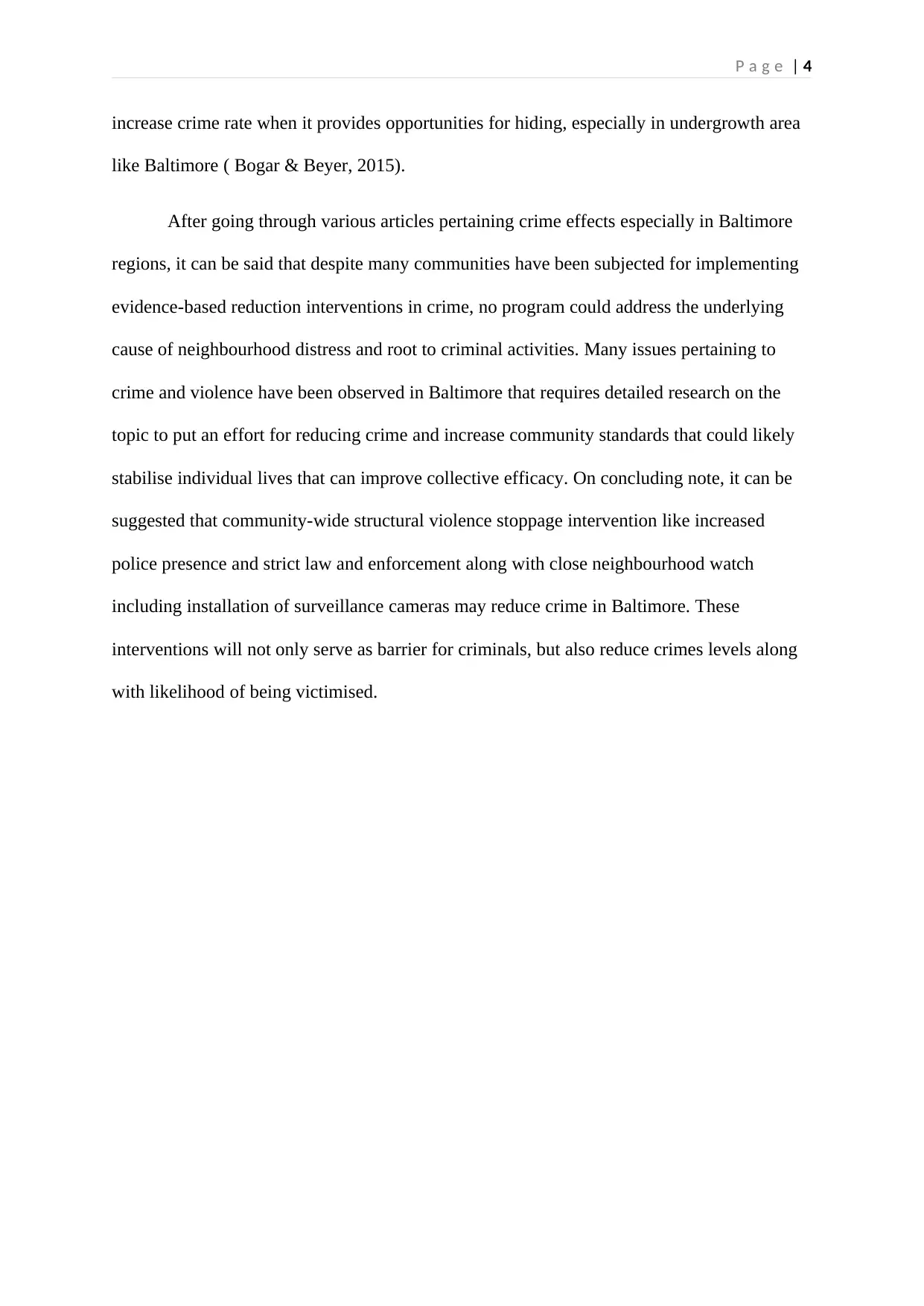
P a g e | 4
increase crime rate when it provides opportunities for hiding, especially in undergrowth area
like Baltimore ( Bogar & Beyer, 2015).
After going through various articles pertaining crime effects especially in Baltimore
regions, it can be said that despite many communities have been subjected for implementing
evidence-based reduction interventions in crime, no program could address the underlying
cause of neighbourhood distress and root to criminal activities. Many issues pertaining to
crime and violence have been observed in Baltimore that requires detailed research on the
topic to put an effort for reducing crime and increase community standards that could likely
stabilise individual lives that can improve collective efficacy. On concluding note, it can be
suggested that community-wide structural violence stoppage intervention like increased
police presence and strict law and enforcement along with close neighbourhood watch
including installation of surveillance cameras may reduce crime in Baltimore. These
interventions will not only serve as barrier for criminals, but also reduce crimes levels along
with likelihood of being victimised.
increase crime rate when it provides opportunities for hiding, especially in undergrowth area
like Baltimore ( Bogar & Beyer, 2015).
After going through various articles pertaining crime effects especially in Baltimore
regions, it can be said that despite many communities have been subjected for implementing
evidence-based reduction interventions in crime, no program could address the underlying
cause of neighbourhood distress and root to criminal activities. Many issues pertaining to
crime and violence have been observed in Baltimore that requires detailed research on the
topic to put an effort for reducing crime and increase community standards that could likely
stabilise individual lives that can improve collective efficacy. On concluding note, it can be
suggested that community-wide structural violence stoppage intervention like increased
police presence and strict law and enforcement along with close neighbourhood watch
including installation of surveillance cameras may reduce crime in Baltimore. These
interventions will not only serve as barrier for criminals, but also reduce crimes levels along
with likelihood of being victimised.
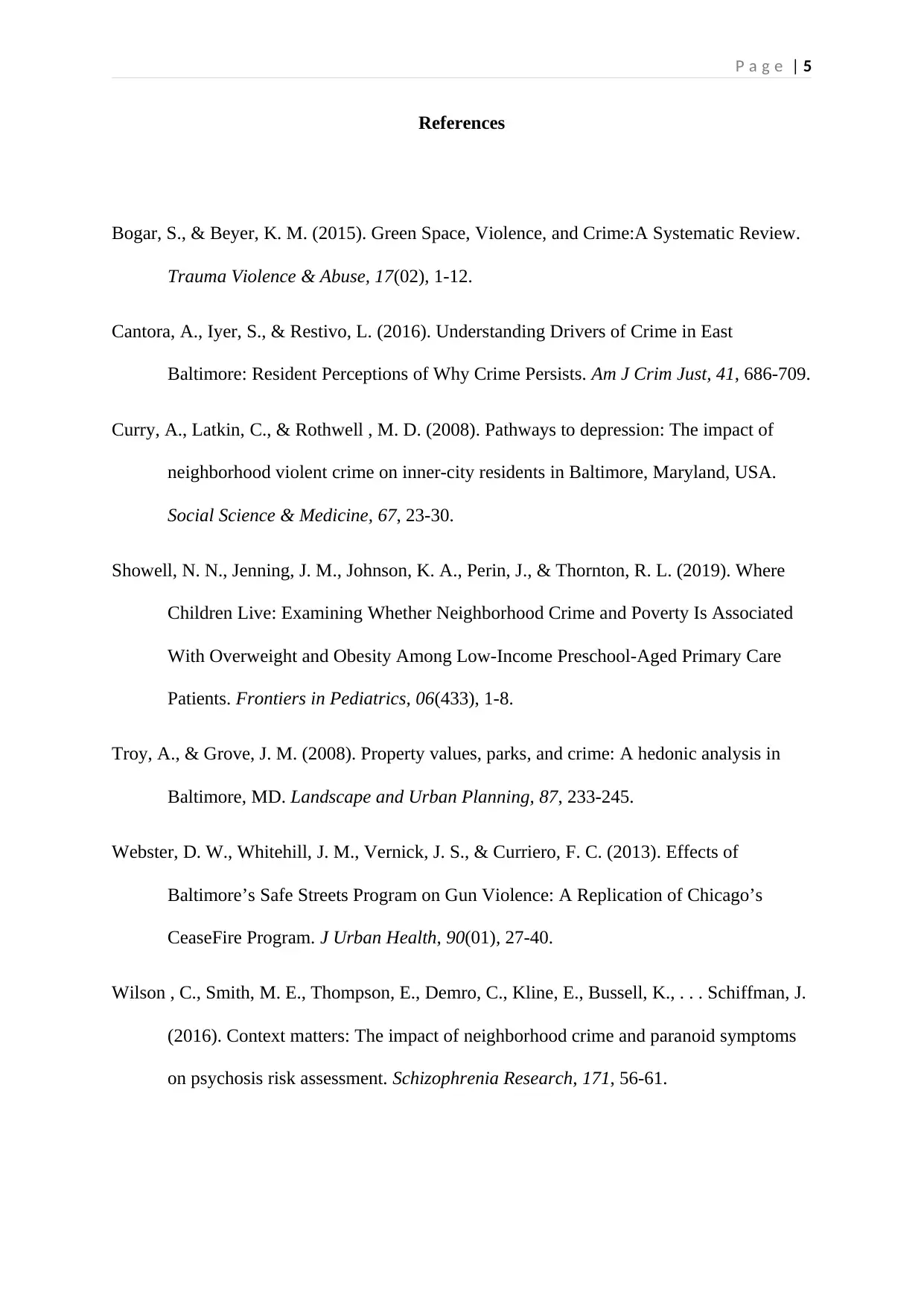
P a g e | 5
References
Bogar, S., & Beyer, K. M. (2015). Green Space, Violence, and Crime:A Systematic Review.
Trauma Violence & Abuse, 17(02), 1-12.
Cantora, A., Iyer, S., & Restivo, L. (2016). Understanding Drivers of Crime in East
Baltimore: Resident Perceptions of Why Crime Persists. Am J Crim Just, 41, 686-709.
Curry, A., Latkin, C., & Rothwell , M. D. (2008). Pathways to depression: The impact of
neighborhood violent crime on inner-city residents in Baltimore, Maryland, USA.
Social Science & Medicine, 67, 23-30.
Showell, N. N., Jenning, J. M., Johnson, K. A., Perin, J., & Thornton, R. L. (2019). Where
Children Live: Examining Whether Neighborhood Crime and Poverty Is Associated
With Overweight and Obesity Among Low-Income Preschool-Aged Primary Care
Patients. Frontiers in Pediatrics, 06(433), 1-8.
Troy, A., & Grove, J. M. (2008). Property values, parks, and crime: A hedonic analysis in
Baltimore, MD. Landscape and Urban Planning, 87, 233-245.
Webster, D. W., Whitehill, J. M., Vernick, J. S., & Curriero, F. C. (2013). Effects of
Baltimore’s Safe Streets Program on Gun Violence: A Replication of Chicago’s
CeaseFire Program. J Urban Health, 90(01), 27-40.
Wilson , C., Smith, M. E., Thompson, E., Demro, C., Kline, E., Bussell, K., . . . Schiffman, J.
(2016). Context matters: The impact of neighborhood crime and paranoid symptoms
on psychosis risk assessment. Schizophrenia Research, 171, 56-61.
References
Bogar, S., & Beyer, K. M. (2015). Green Space, Violence, and Crime:A Systematic Review.
Trauma Violence & Abuse, 17(02), 1-12.
Cantora, A., Iyer, S., & Restivo, L. (2016). Understanding Drivers of Crime in East
Baltimore: Resident Perceptions of Why Crime Persists. Am J Crim Just, 41, 686-709.
Curry, A., Latkin, C., & Rothwell , M. D. (2008). Pathways to depression: The impact of
neighborhood violent crime on inner-city residents in Baltimore, Maryland, USA.
Social Science & Medicine, 67, 23-30.
Showell, N. N., Jenning, J. M., Johnson, K. A., Perin, J., & Thornton, R. L. (2019). Where
Children Live: Examining Whether Neighborhood Crime and Poverty Is Associated
With Overweight and Obesity Among Low-Income Preschool-Aged Primary Care
Patients. Frontiers in Pediatrics, 06(433), 1-8.
Troy, A., & Grove, J. M. (2008). Property values, parks, and crime: A hedonic analysis in
Baltimore, MD. Landscape and Urban Planning, 87, 233-245.
Webster, D. W., Whitehill, J. M., Vernick, J. S., & Curriero, F. C. (2013). Effects of
Baltimore’s Safe Streets Program on Gun Violence: A Replication of Chicago’s
CeaseFire Program. J Urban Health, 90(01), 27-40.
Wilson , C., Smith, M. E., Thompson, E., Demro, C., Kline, E., Bussell, K., . . . Schiffman, J.
(2016). Context matters: The impact of neighborhood crime and paranoid symptoms
on psychosis risk assessment. Schizophrenia Research, 171, 56-61.
⊘ This is a preview!⊘
Do you want full access?
Subscribe today to unlock all pages.

Trusted by 1+ million students worldwide
1 out of 6
Your All-in-One AI-Powered Toolkit for Academic Success.
+13062052269
info@desklib.com
Available 24*7 on WhatsApp / Email
![[object Object]](/_next/static/media/star-bottom.7253800d.svg)
Unlock your academic potential
Copyright © 2020–2025 A2Z Services. All Rights Reserved. Developed and managed by ZUCOL.